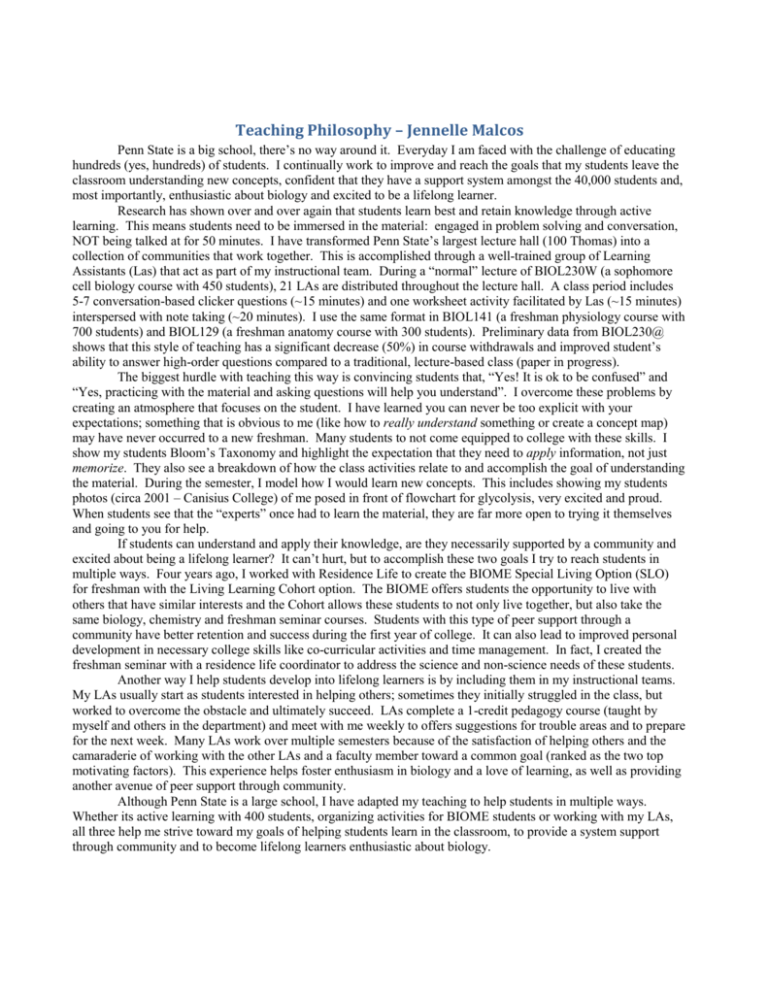Teaching Philosophy – Jennelle Malcos
advertisement

Teaching Philosophy – Jennelle Malcos Penn State is a big school, there’s no way around it. Everyday I am faced with the challenge of educating hundreds (yes, hundreds) of students. I continually work to improve and reach the goals that my students leave the classroom understanding new concepts, confident that they have a support system amongst the 40,000 students and, most importantly, enthusiastic about biology and excited to be a lifelong learner. Research has shown over and over again that students learn best and retain knowledge through active learning. This means students need to be immersed in the material: engaged in problem solving and conversation, NOT being talked at for 50 minutes. I have transformed Penn State’s largest lecture hall (100 Thomas) into a collection of communities that work together. This is accomplished through a well-trained group of Learning Assistants (Las) that act as part of my instructional team. During a “normal” lecture of BIOL230W (a sophomore cell biology course with 450 students), 21 LAs are distributed throughout the lecture hall. A class period includes 5-7 conversation-based clicker questions (~15 minutes) and one worksheet activity facilitated by Las (~15 minutes) interspersed with note taking (~20 minutes). I use the same format in BIOL141 (a freshman physiology course with 700 students) and BIOL129 (a freshman anatomy course with 300 students). Preliminary data from BIOL230@ shows that this style of teaching has a significant decrease (50%) in course withdrawals and improved student’s ability to answer high-order questions compared to a traditional, lecture-based class (paper in progress). The biggest hurdle with teaching this way is convincing students that, “Yes! It is ok to be confused” and “Yes, practicing with the material and asking questions will help you understand”. I overcome these problems by creating an atmosphere that focuses on the student. I have learned you can never be too explicit with your expectations; something that is obvious to me (like how to really understand something or create a concept map) may have never occurred to a new freshman. Many students to not come equipped to college with these skills. I show my students Bloom’s Taxonomy and highlight the expectation that they need to apply information, not just memorize. They also see a breakdown of how the class activities relate to and accomplish the goal of understanding the material. During the semester, I model how I would learn new concepts. This includes showing my students photos (circa 2001 – Canisius College) of me posed in front of flowchart for glycolysis, very excited and proud. When students see that the “experts” once had to learn the material, they are far more open to trying it themselves and going to you for help. If students can understand and apply their knowledge, are they necessarily supported by a community and excited about being a lifelong learner? It can’t hurt, but to accomplish these two goals I try to reach students in multiple ways. Four years ago, I worked with Residence Life to create the BIOME Special Living Option (SLO) for freshman with the Living Learning Cohort option. The BIOME offers students the opportunity to live with others that have similar interests and the Cohort allows these students to not only live together, but also take the same biology, chemistry and freshman seminar courses. Students with this type of peer support through a community have better retention and success during the first year of college. It can also lead to improved personal development in necessary college skills like co-curricular activities and time management. In fact, I created the freshman seminar with a residence life coordinator to address the science and non-science needs of these students. Another way I help students develop into lifelong learners is by including them in my instructional teams. My LAs usually start as students interested in helping others; sometimes they initially struggled in the class, but worked to overcome the obstacle and ultimately succeed. LAs complete a 1-credit pedagogy course (taught by myself and others in the department) and meet with me weekly to offers suggestions for trouble areas and to prepare for the next week. Many LAs work over multiple semesters because of the satisfaction of helping others and the camaraderie of working with the other LAs and a faculty member toward a common goal (ranked as the two top motivating factors). This experience helps foster enthusiasm in biology and a love of learning, as well as providing another avenue of peer support through community. Although Penn State is a large school, I have adapted my teaching to help students in multiple ways. Whether its active learning with 400 students, organizing activities for BIOME students or working with my LAs, all three help me strive toward my goals of helping students learn in the classroom, to provide a system support through community and to become lifelong learners enthusiastic about biology.




